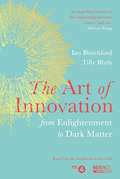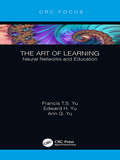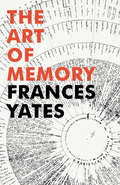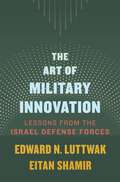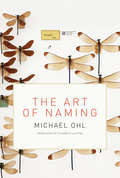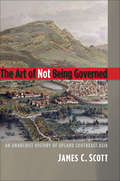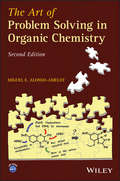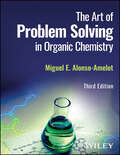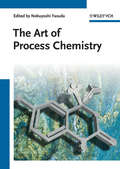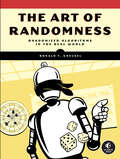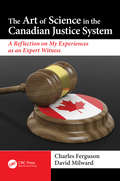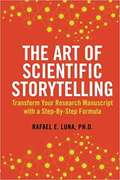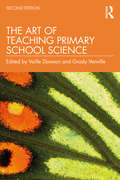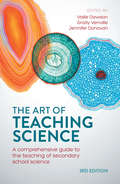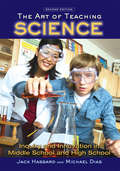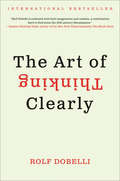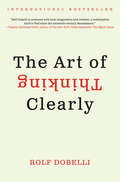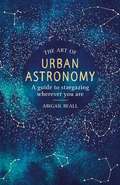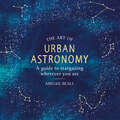- Table View
- List View
The Art of Innovation: From Enlightenment to Dark Matter, as featured on Radio 4
by Ian Blatchford Tilly BlythBased on the landmark Radio 4 series, this beautifully illustrated modern history of the connections between science and art offers a new perspective on what that relationship has contributed to the world around us. __________ Throughout history, artists and scientists have been driven by curiosity and the desire to experiment. Both have wanted to make sense of the world around them, often to change it, sometimes working closely together, certainly taking inspiration from each other's disciplines. The relationship between the two has traditionally been perceived as one of love and hate, fascination and revulsion, symbiotic but antagonistic. But art is crucial to helping us understand our science legacy and science is well served by applying an artistic lens. How exactly has the ingenuity of science and technology been incorporated into artistic expression? And how has creative practice, in turn, stimulated innovation and technological change?The Art of Innovation is a history of the past 250 years viewed through the disciplines of art and science. Through fascinating stories that explore the sometimes unexpected relationships between famous artworks and significant scientific and technological objects - from Constable's cloudscapes and the chemist who first measured changes in air pressure, to the introduction of photography and the representation of natural history in print - it offers a new way of seeing, studying and interpreting the extraordinary world around us.
The Art of Learning: Neural Networks and Education
by Francis T.S. Yu Edward H. Yu Ann G. YuThis book presents the idea that innovative ways of teaching and learning are very essential to retention and growth. Presented in 15 sections, the book starts with the common sense training on education and moves on to neural network operation. Throughout the book, the art of learning, associative, cognitive, and creative learning are stated and defined. Learning simplicity, information content as related to neural network learning are discussed. The author also discusses neural plasticity and adaptability in smarter neural networks. If we know our human brain’s basic abilities and limitation then a better educational methods can be implemented. Presents the idea that innovative ways of teaching and learning are very essential to retention and growth Discusses major differences and constraints between neural network and computer Presents the significances of learning simplicity and information content as related to neural network learning are included Stresses the neural network learning capabilities and limitations and their role in developing more efficient learning techniques
The Art of Measuring in the Thermal Sciences (Heat Transfer)
by Michel De Paepe Josua P. MeyerThe Art of Measuring in the Thermal Sciences provides an original state-of-the-art guide to scholars who are conducting thermal experiments in both academia and industry. Applications include energy generation, transport, manufacturing, mining, processes, HVAC&R, etc. This book presents original insights into advanced measurement techniques and systems, explores the fundamentals, and focuses on the analysis and design of thermal systems. Discusses the advanced measurement techniques now used in thermal systems Links measurement techniques to concepts in thermal science and engineering Draws upon the original work of current researchers and experts in thermal-fluid measurement Includes coverage of new technologies, such as micro-level heat transfer measurements Covers the main types of instrumentation and software used in thermal-fluid measurements This book offers engineers, researchers, and graduate students an overview of the best practices for conducting sound measurements in the thermal sciences.
The Art of Memory
by Frances A YatesThis unique and brilliant book is a history of human knowledge. Before the invention of printing, a trained memory was of vital importance. Based on a technique of impressing 'places' and 'images' on the mind, the ancient Greeks created an elaborate memory system which in turn was inherited by the Romans and passed into the European tradition, to be revived, in occult form, during the Renaissance. Frances Yates sheds light on Dante’s Divine Comedy, the form of the Shakespearian theatre and the history of ancient architecture; The Art of Memory is an invaluable contribution to aesthetics and psychology, and to the history of philosophy, of science and of literature.
The Art of Military Innovation: Lessons From The Israel Defense Forces
by Edward N. Luttwak Eitan ShamirA world-leading military strategist and an IDF insider explain the improbable success of the Israeli armed forces.When the Israel Defense Forces was established in May 1948, it was small, poorly equipped, and already at war. Lacking sufficient weaponry or the domestic industrial base to produce it, the newborn military was forced to make do with whatever it could get its hands on. That spirit of improvisation carried the IDF to a decisive victory in the First Arab-Israeli War.Today the same spirit has made the IDF the most powerful military in the Middle East and among the most capable in the world. In The Art of Military Innovation, Edward N. Luttwak and Eitan Shamir trace the roots of this astounding success. What sets the IDF apart, they argue, is its singular organizational structure. From its inception, it has been the world’s only one-service military, encompassing air, naval, and land forces in a single institutional body. This unique structure, coupled with a young officer corps, allows for initiative from below. The result is a nimble organization inclined toward change rather than beholden to tradition.The IDF has fostered some of the most significant advances in military technology of the past seventy years, from the first wartime use of drones to the famed Iron Dome missile defense system, and now the first laser weapon, Iron Beam. Less-heralded innovations in training, logistics, and human resources have been equally important. Sharing rich insights and compelling stories, Luttwak and Shamir reveal just what makes the IDF so agile and effective.
The Art of Molecular Dynamics Simulation
by D. C. RapaportIn this Second Edition an extensive series of detailed case studies introduces the reader to solutions to a variety of problems connected with the way molecular interactions and motions determine the properties of matter. The methods are widely used in studying phenomena involving everything from the simplest of liquids to highly complex molecules such as proteins. In addition to a significant amount of new material, this edition features completely rewritten software. First Edition Hb (1996): 0-521-44561-2 First Edition Pb (1996): 0-521-59942-3
The Art of More: How Mathematics Created Civilization
by Michael BrooksAn illuminating, millennia-spanning history of the impact mathematics has had on the world, and the fascinating people who have mastered its inherent power, from Babylonian tax officials to the Apollo astronauts to the eccentric professor who invented the infrastructure of the online worldCounting is not innate to our nature, and without education humans can rarely count past three—beyond that, it&’s just &“more.&” But once harnessed by our ancestors, the power of numbers allowed humanity to flourish in ways that continue to lead to discoveries and enrich our lives today. Ancient tax collectors used basic numeracy to fuel the growth of early civilization, navigators used clever geometrical tricks to engage in trade and connect people across vast distances, astronomers used logarithms to unlock the secrets of the heavens, and their descendants put them to use to land us on the moon. In every case, mathematics has proved to be a greatly underappreciated engine of human progress. In this captivating, sweeping history, Michael Brooks acts as our guide through the ages. He makes the case that mathematics was one of the foundational innovations that catapulted humanity from a nomadic existence to civilization, and that it has since then been instrumental in every great leap of humankind. Here are ancient Egyptian priests, Babylonian bureaucrats, medieval architects, dueling Swiss brothers, and renaissance painters. Their stories clearly demonstrate that the invention of mathematics was every bit as important to the human species as was the discovery of fire. From first page to last, The Art of More brings mathematics back into the heart of what it means to be human.
The Art of Naming
by Michael OhlFrom Tyrannosaurus rex to Heteropoda davidbowie: scientific naming as a joyful and creative act. Tyrannosaurus rex. Homo sapiens. Heteropoda davidbowie. Behind each act of scientific naming is a story. In this entertaining and illuminating book, Michael Ohl considers scientific naming as a joyful and creative act. There are about 1.8 million discovered and named plant and animal species, and millions more still to be discovered. Naming is the necessary next step after discovery; it is through the naming of species that we perceive and understand nature. Ohl explains the process, with examples, anecdotes, and a wildly varied cast of characters. He describes the rules for scientific naming; the vernacular isn't adequate. These rules—in standard binomial nomenclature, the generic name followed by specific name—go back to Linnaeus; but they are open to idiosyncrasy and individual expression. A lizard is designated Barbaturex morrisoni (in honor of the Doors' Jim Morrison, the Lizard King); a member of the horsefly family Scaptia beyonceae. Ohl, a specialist in “winged things that sting,” confesses that among the many wasp species he has named is Ampulex dementor, after the dementors in the Harry Potter novels. Scientific names have also been deployed by scientists to insult other scientists, to make political statements, and as expressions of romantic love: “I shall name this beetle after my beloved wife.” The Art of Naming takes us on a surprising and fascinating journey, in the footsteps of the discoverers of species and the authors of names, into the nooks and crannies and drawers and cabinets of museums, and through the natural world of named and not-yet-named species.
The Art of Not Being Governed: An Anarchist History of Upland Southeast Asia
by James C. ScottFor two thousand years the disparate groups that now reside in Zomia (a mountainous region the size of Europe that consists of portions of seven Asian countries) have fled the projects of the organized state societies that surround them--slavery, conscription, taxes, corvée labor, epidemics, and warfare. This book, essentially an "anarchist history," is the first-ever examination of the huge literature on state-making whose author evaluates why people would deliberately and reactively remain stateless. Among the strategies employed by the people of Zomia to remain stateless are physical dispersion in rugged terrain; agricultural practices that enhance mobility; pliable ethnic identities; devotion to prophetic, millenarian leaders; and maintenance of a largely oral culture that allows them to reinvent their histories and genealogies as they move between and around states. In accessible language, James Scott, recognized worldwide as an eminent authority in Southeast Asian, peasant, and agrarian studies, tells the story of the peoples of Zomia and their unlikely odyssey in search of self-determination. He redefines our views on Asian politics, history, demographics, and even our fundamental ideas about what constitutes civilization, and challenges us with a radically different approach to history that presents events from the perspective of stateless peoples and redefines state-making as a form of "internal colonialism." This new perspective requires a radical reevaluation of the civilizational narratives of the lowland states. Scott's work on Zomia represents a new way to think of area studies that will be applicable to other runaway, fugitive, and marooned communities, be they Gypsies, Cossacks, tribes fleeing slave raiders, Marsh Arabs, or San-Bushmen.
The Art of Problem Solving in Organic Chemistry
by Miguel E. Alonso-AmelotThis long-awaited new edition helps students understand and solve the complex problems that organic chemists regularly face, using a step-by-step method and approachable text. With solved and worked-through problems, the author orients discussion of each through the application of various problem-solving techniques. Teaches organic chemists structured and logical techniques to solve reaction problems and uses a unique, systematic approach. Stresses the logic and strategy of mechanistic problem solving -- a key piece of success for organic chemistry, beyond just specific reactions and facts Has a conversational tone and acts as a readable and approachable workbook allowing reader involvement instead of simply straightforward text Uses 60 solved and worked-through problems and reaction schemes for students to practice with, along with updated organic reactions and illustrated examples Includes website with supplementary material for chapters and problems: http://tapsoc.yolasite.com
The Art of Problem Solving in Organic Chemistry
by Miguel E. Alonso-AmelotThe Art of Problem Solving in Organic Chemistry The new edition of the classic textbook that has helped thousands of students understand and solve the complex mechanistic problems posed by organic reactions The Art of Problem Solving in Organic Chemistry is a must-have handbook for students and professionals alike, offering step-by-step guidance on applying proven strategies and logical techniques to solve complex reaction mechanism problems. With a straightforward approach and conversational style, this highly practical resource provides fully worked organic reaction problems that increase in difficulty from basic to advanced. Organized by specific analysis technique, the problems include complete and accurate discussions of the mechanisms, alternative pathways, comparisons with related reactions, data from quantum chemical calculations, critical reviews of current methods, real-world research and reaction schemes, and illustrated examples. Now in its third edition, The Art of Problem Solving in Organic Chemistry retains the structure of previous editions, previously rated among the 30 best organic chemistry books of all time by BookAuthority. More than 50 revised organic reaction mechanism problems are complemented by an entirely new set of problems, additional concepts and techniques, expanded coverage of applications in contemporary organic chemistry, embedded cases of the existing reaction pool taken from recent literature, and much more. Describes the principles, methods, tools, and problem analysis techniques required to solve organic reaction problems Extends the logic and strategy of the mechanistic approach beyond specific reactions and facts Discusses practical methods for improved problem solving for organic reaction mechanisms Explains tested strategies for analyzing the possibilities of reaction mechanisms between reactants and products Contains detailed appendices with definitions and examples of principles, reactions, mechanisms, and reagents The Art of Problem Solving in Organic Chemistry, Third Edition is an essential volume for advanced undergraduates, graduate students, lecturers, and professionals looking to improve their performance in finding solutions to organic reaction problems. It is an ideal textbook for courses on organic reactions and problem analysis, as well as an excellent supplement for courses covering reactive intermediates and mechanisms of molecular transformations.
The Art of Process Chemistry
by Nobuyoshi YasudaProviding must-have knowledge for the pharmaceutical industry and process chemists in industry, this ready reference offers solutions for saving time and money and supplying -- in a sustainable way -- valuable products. Application-oriented and well structured, each chapter presents successful strategies for the latest modern drugs, showing how to provide very fast bulk quantities of drug candidates. Throughout, the text illustrates how all the key factors are interwoven and dependent on one another in creating optimized methods for optimal products.
The Art of Randomness: Randomized Algorithms in the Real World
by Ronald T. KneuselHarness the power of randomness (and Python code) to solve real-world problems in fun, hands-on experiments—from simulating evolution to encrypting messages to making machine-learning algorithms!The Art of Randomness is a hands-on guide to mastering the many ways you can use randomized algorithms to solve real programming and scientific problems. You&’ll learn how to use randomness to run simulations, hide information, design experiments, and even create art and music. All you need is some Python, basic high school math, and a roll of the dice.Author Ronald T. Kneusel focuses on helping you build your intuition so that you&’ll know when and how to use random processes to get things done. You&’ll develop a randomness engine (a Python class that supplies random values from your chosen source), then explore how to leverage randomness to:Simulate Darwinian evolution and optimize with swarm-based search algorithmsDesign scientific experiments to produce more meaningful results by making them truly randomImplement machine learning algorithms like neural networks and random forestsUse Markov Chain Monte Carlo methods to sample from complex distributionsHide information in audio files and images, generate art, and create musicReconstruct original signals and images from only randomly sampled dataScientific anecdotes and code examples throughout illustrate how randomness plays into areas like optimization, machine learning, and audio signals. End-of-chapter exercises encourage further exploration.Whether you&’re a programmer, scientist, engineer, mathematician, or artist, you&’ll find The Art of Randomness to be your ticket to discovering the hidden power of applied randomness and the ways it can transform your approach to solving problems, from the technical to the artistic.
The Art of Science
by Rossella Lupacchini Annarita AngeliniIn addition to linear perspective, complex numbers and probability were notable discoveries of the Renaissance. While the power of perspective, which transformed Renaissance art, was quickly recognized, the scientific establishment treated both complex numbers and probability with much suspicion. It was only in the twentieth century that quantum theory showed how probability might be molded from complex numbers and defined the notion of "complex probability amplitude". From a theoretical point of view, however, the space opened to painting by linear perspective and that opened to science by complex numbers share significant characteristics. The Art of Science explores this shared field with the purpose of extending Leonardo's vision of painting to issues of mathematics and encouraging the reader to see science as an art. The intention is to restore a visual dimension to mathematical sciences - an element dulled, if not obscured, by historians, philosophers, and scientists themselves.
The Art of Science in the Canadian Justice System: A Reflection of My Experiences as an Expert Witness
by Charles Ferguson David MilwardPart autobiography, part thought piece, part references, the book takes an insightful look at the experience and cases of renowned paediatrician and forensic expert witness Dr. Charles Ferguson. The book presents the interaction of science and law as it applies, specifically, the Canadian courts, but the justice process as a whole. Dr. Ferguson’s experience—from a scientist and medical professional’s perspective—in dealing with lawyers, judges, and the process of testifying in numerous court—offers a unique glimpse into how the two worlds of science and law don’t always mesh. In some cases the evidence is compelling and definitive. In others, far from it. Ultimately, the book presents the important role of the forensic expert and expert witness as a vital and deciding factor as the courtroom proceedings play out. The cases presented in the book—cases Dr. Ferguson was personally involved with—are interesting, the conclusions and results arrived at by Dr. Ferguson are well thought out and backed by his scientific expertise. The results and conclusions arrived at by the courts is often expected, sometimes surprising—in specific cases even controversial. Throughout all, Dr. Ferguson casts an independent, and sometimes critical, eye on the process presenting a compelling argument and heartfelt recommendation for science, objectivity, and justice to be served based on truth—truth insofar as the "facts" of the cases presented through evidence and the testimony provided within the judicial process. A fascinating read for university students, experts and witnesses, lawyers and judges, and anyone involved in the forensic process in the trying of criminal and civil cases.
The Art of Scientific Storytelling: Transform Your Research Manuscript with a Step-by-Step Formula
by Rafael LunaWe all want our research to have an impact and to be cited by others. There are thousands of research articles published in our respective fields. How do we get someone to read our publications? This book shows you how to put your Title and Abstract into a story, along with the rest of your manuscript. Your research will stand out in a sea of peer-review publications, since it will be forged into a Scientific Story. As a research fellow in the laboratory of Professor Gerhard Wagner at Harvard Medical School, Dr. Luna was collaborating with four other top-notch laboratories in an interdisciplinary research effort to understand the end of the scanning mechanism required for protein synthesis in cells. They were sitting on a mound of research data collected by the various laboratories with varying expertise. This super-collaboration consisted of Physicists, Biologists, Structural Biologists, Biochemists, Chemists, a Computer Scientist, and a Chemical Engineer. There was so much data; yet they struggled to fashion a logical story for a peer-review publication. Dr. Luna was stuck. This book is written by an active research scientist, as a guide for other scientists doing research. This is how science should be written.
The Art of Teaching Primary School Science
by Grady Venville Vaille DawsonThe long-awaited second edition of The Art of Teaching Primary School Science has evolved to meet the demands of schools in our rapidly changing society. Recognising that children have an innate curiosity about the natural world means that teaching primary school science is both rewarding and critical to their futures. The focus of the chapters reflects the deep expertise in curriculum and pedagogy of the chapter authors. Included are chapters on the nature (wonder) of science and how children learn as well as the nuts and bolts of teaching: planning, pedagogy and assessment. In addressing the teacher education AITSL professional standards for teaching, there are chapters on digital pedagogies, differentiation and advanced pedagogies such as problem-based learning. Finally, there is a section on STEM education that explains how an integrated approach can be planned, taught and assessed. This book is both accessible to all preservice and practising teachers and up-to-date in providing the right mix of theoretical and practical knowledge expected of this generation of primary school teachers. Teacher educators worldwide will find this an essential resource.
The Art of Teaching Science: A comprehensive guide to the teaching of secondary school science
by Jennifer Donovan Grady Venville Vaille DawsonThe Art of Teaching Science has proven itself to be one of the most popular introductory texts for Australian pre-service and in-service teachers, providing guidance on engaging students and helping develop scientifically literate citizens. Beginning with an examination of the nature of science, constructivist and socio-cultural views of teaching and learning and contemporary science curricula in Australian schools, the expert authors go on to explore effective teaching and learning strategies, approaches to assessment and provide advice on the use of ICT in the classroom. Fully revised and updated, this edition also reflects the introduction of the AITSL professional standards for teachers and integrates them throughout the text. New chapters explore: •a range of teaching strategies including explicit instruction, active learning and problem-based learning; •the effective integration of STEM in schools; •approaches to differentiation in science education; and•contemporary uses of ICT to improve student learning. Those new to this text will find it is deliberately written in user-friendly language. Each chapter stands alone, but collectively they form a coherent picture of the art (in the sense of creative craft) and science (as in possessing the knowledge, understanding and skills) required to effectively teach secondary school science. 'Helping each new generation of school science teachers as they begin their careers is crucial to education. This is the updated, third edition of this valuable textbook. It contains a wonderful range of inspirational chapters. All science teachers, not only those at the start of the profession, would benefit from it, in Australia and beyond.'Michael J. Reiss, Professor of Science Education, University College, London
The Art of Teaching Science: Inquiry and Innovation in Middle School and High School
by Michael Dias Jack HassardThe Art of Teaching Science emphasizes a humanistic, experiential, and constructivist approach to teaching and learning, and integrates a wide variety of pedagogical tools. Becoming a science teacher is a creative process, and this innovative textbook encourages students to construct ideas about science teaching through their interactions with peers, mentors, and instructors, and through hands-on, minds-on activities designed to foster a collaborative, thoughtful learning environment. This second edition retains key features such as inquiry-based activities and case studies throughout, while simultaneously adding new material on the impact of standardized testing on inquiry-based science, and explicit links to science teaching standards. Also included are expanded resources like a comprehensive website, a streamlined format and updated content, making the experiential tools in the book even more useful for both pre- and in-service science teachers. Special Features: Each chapter is organized into two sections: one that focuses on content and theme; and one that contains a variety of strategies for extending chapter concepts outside the classroom Case studies open each chapter to highlight real-world scenarios and to connect theory to teaching practice Contains 33 Inquiry Activities that provide opportunities to explore the dimensions of science teaching and increase professional expertise Problems and Extensions, On the Web Resources and Readings guide students to further critical investigation of important concepts and topics. An extensive companion website includes even more student and instructor resources, such as interviews with practicing science teachers, articles from the literature, chapter PowerPoint slides, syllabus helpers, additional case studies, activities, and more. Visit http://www.routledge.com/textbooks/9780415965286 to access this additional material.
The Art of Thinking Clearly
by Rolf DobelliHave you ever . . . Invested time in something that, in hindsight, just wasnt worth it? Paid too much in an eBay auction? Continued to do something you knew was bad for you? Sold stocks too late, or too early? Taken credit for success, but blamed failure on external circumstances? Backed the wrong horse?These are examples of what the author calls cognitive biases, simple errors all of us make in day-to-day thinking. But by knowing what they are and how to identify them, we can avoid them and make better choices: whether in dealing with personal problems or business negotiations, trying to save money or earn profits, or merely working out what we really want in life--and strategizing the best way to get it. Already an international bestseller, The Art of Thinking Clearly distills cutting-edge research from behavioral economics, psychology, and neuroscience into a clever, practical guide for anyone whos ever wanted to be wiser and make better decisions. A novelist, thinker, and entrepreneur, Rolf Dobelli deftly shows that in order to lead happier, more prosperous lives, we dont need extra cunning, new ideas, shiny gadgets, or more frantic hyperactivity--all we need is less irrationality. Simple, clear, and always surprising, this indispensable book will change the way you think and transform your decision making--at work, at home, every day. From why you shouldnt accept a free drink to why you should walk out of a movie you dont like, from why its so hard to predict the future to why you shouldnt watch the news, The Art of Thinking Clearly helps solve the puzzle of human reasoning.
The Art of Thinking Clearly
by Rolf DobelliHave you ever . . . Invested time in something that, in hindsight, just wasn't worth it? Paid too much in an eBay auction? Continued to do something you knew was bad for you? Sold stocks too late, or too early? Taken credit for success, but blamed failure on external circumstances? Backed the wrong horse?These are examples of what the author calls cognitive biases, simple errors all of us make in day-to-day thinking. But by knowing what they are and how to identify them, we can avoid them and make better choices: whether in dealing with personal problems or business negotiations, trying to save money or earn profits, or merely working out what we really want in life--and strategizing the best way to get it.Already an international bestseller, The Art of Thinking Clearly distills cutting-edge research from behavioral economics, psychology, and neuroscience into a clever, practical guide for anyone who's ever wanted to be wiser and make better decisions. A novelist, thinker, and entrepreneur, Rolf Dobelli deftly shows that in order to lead happier, more prosperous lives, we don't need extra cunning, new ideas, shiny gadgets, or more frantic hyperactivity--all we need is less irrationality.Simple, clear, and always surprising, this indispensable book will change the way you think and transform your decision making--at work, at home, every day. From why you shouldn't accept a free drink to why you should walk out of a movie you don't like, from why it's so hard to predict the future to why you shouldn't watch the news, The Art of Thinking Clearly helps solve the puzzle of human reasoning.
The Art of Tinkering: Meet 150+ Makers Working at the Intersection of Art, Science & Technology
by Exploratorium Karen Wilkinson Mike PetrichSome of the most creative artists from today&’s maker scene discuss their process, workspaces and more in this inspiring guide to tinkering. The Art of Tinkering is an unprecedented celebration of what it means to tinker: to take things apart, explore tools and materials, and build wondrous, wild art that&’s part science, part technology, and entirely creative. Join 150+ makers as they share the stories behind their beautiful and bold work—then do some tinkering yourself! This collection of exhibits, artwork, and projects explores a whole new way to learn, in which people expand their knowledge through making and doing, working with readily available materials, getting their hands dirty, collaborating with others, and problem-solving in the most fun sense of the word. Each artist featured in The Art of Tinkering shares their process and the backstory behind their work. Whether it&’s dicussing their favorite tools (who knew toenail clippers could be so handy?) or offering a glimpse of their workspaces (you&’d be amazed how many electronics tools you can pack into a pantry!), the stories, lessons, and tips in The Art of Tinkering offer a fascinating portrait of today&’s maker scene. Artists include: Scott Weaver, Arthur Ganson, Moxie, Tim Hunkin, AnnMarie Thomas, Ranjit Bhatnajar and Jie Qi.
The Art of Urban Astronomy: A Guide to Stargazing Wherever You Are
by Abigail BeallDid you know that stars are seasonal? That Orion is one of the brightest constellations? That a single day on Venus is longer than an entire year on Venus? Space has captivated mankind since the beginning of time. Fifty years ago, Neil Armstrong became the first man to step on the moon and since then our knowledge of astronomy has continued to expand. With so many mysteries yet to be solved, science journalist Abigail Beall takes readers on an astonishing journey though the landscape of space. In The Art of Urban Astronomy, you will be guided through the seasons and learn about the brightest stars and constellations, the myths and legends of astronomy and how to identify star clusters and galaxies with just your eyes or a pair of binoculars. For urban dwellers wrapped up in the rush and bustle of the city, it can be calming and truly valuable to take the time simply to stop, look and reconnect with nature. Packed full of seasonal star charts, constellation charts and fascinating facts, this is the perfect guide for those who have looked up at the night sky and don't know where to begin. After reading this book, you'll never look up in the same way again.
The Art of Urban Astronomy: A Guide to Stargazing Wherever You Are
by Abigail BeallDid you know that stars are seasonal? That Orion is one of the brightest constellations? That a single day on Venus is longer than an entire year on Venus? Space has captivated mankind since the beginning of time. Fifty years ago, Neil Armstrong became the first man to step on the moon and since then our knowledge of astronomy has continued to expand. With so many mysteries yet to be solved, science journalist Abigail Beall takes readers on an astonishing journey though the landscape of space. In The Art of Urban Astronomy, you will be guided through the seasons and learn about the brightest stars and constellations, the myths and legends of astronomy and how to identify star clusters and galaxies with just your eyes or a pair of binoculars. For urban dwellers wrapped up in the rush and bustle of the city, it can be calming and truly valuable to take the time simply to stop, look and reconnect with nature. Packed full of seasonal star charts, constellation charts and fascinating facts, this is the perfect guide for those who have looked up at the night sky and don't know where to begin. After reading this book, you'll never look up in the same way again.
The Art of Urban Astronomy: A Guide to Stargazing Wherever You Are
by Abigail BeallDid you know that stars are seasonal? That Orion is one of the brightest constellations? That a single day on Venus is longer than an entire year on Venus? Space has captivated mankind since the beginning of time. Fifty years ago, Neil Armstrong became the first man to step on the moon and since then our knowledge of astronomy has continued to expand. With so many mysteries yet to be solved, science journalist Abigail Beall takes readers on an astonishing journey though the landscape of space. In The Art of Urban Astronomy, you will be guided through the seasons and learn about the brightest stars and constellations, the myths and legends of astronomy and how to identify star clusters and galaxies with just your eyes or a pair of binoculars. For urban dwellers wrapped up in the rush and bustle of the city, it can be calming and truly valuable to take the time simply to stop, look and reconnect with nature. Packed full of seasonal star charts, constellation charts and fascinating facts, this is the perfect guide for those who have looked up at the night sky and don't know where to begin. After reading this book, you'll never look up in the same way again.
